arduino upload program particle sensor serial monitor doesnt work
GPS sensors can provide existent time position data in your Arduino projects. Past detecting breadth, longitude, altitude, velocity, and heading, they're an indispensable tool for autonomous vehicles and other devices where the global position needs to be known. In this commodity, we will set upwards a GPS sensor on the Arduino and learn how to work with the data it provides.

Overview of a GPS Sensor
The GPS nosotros are going to use is the Adafruit Ultimate GPS Breakout. It'southward one of the more reliable GPS units you can get:
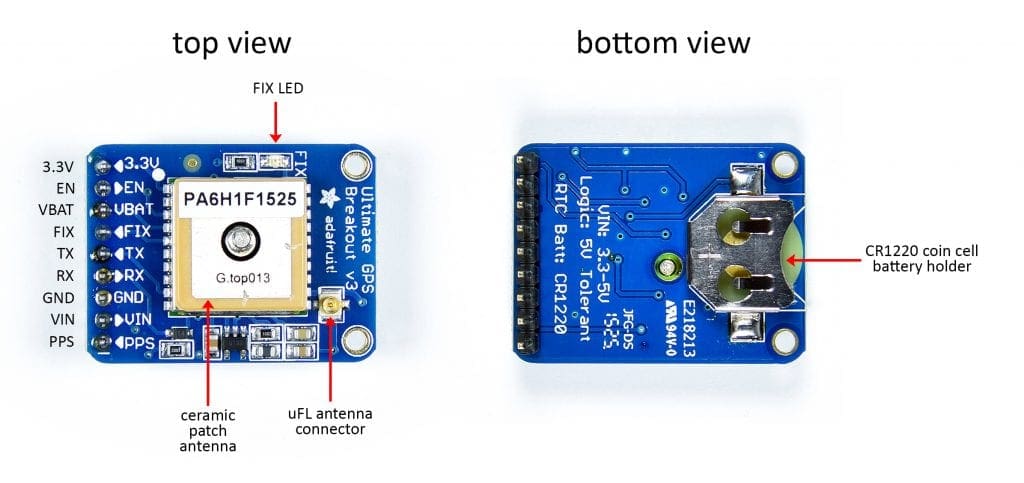
The Adafruit Ultimate GPS Breakout uses the MTK3339 GPS chip from MediaTek. The GPS chip is located underneath the tan ceramic patch antenna. The GPS has uFL connection that is used to connect an external antenna. The FIX LED blinks to permit yous know if there's a satellite fix. On the bottom side is a coin prison cell battery holder so the GPS can keep satellite fixes later on the main power is turned off. The GPS tin be powered with either three.iii volts or 5 volts.
The Ultimate GPS Sensor Breakout has nine pins:
- VIN – Used to power the GPS. It connects to either iii.3 volts or v volts.
- 3.3V – Provides a iii.3 volt power supply that tin ability other devices.
- EN – Enable pin. It's high by default but if pulled low the GPS volition plough off.
- VBATT – Bombardment pin. Information technology's connected to the positive final of the money cell battery. This is where you can input 3.iii volts from a coin prison cell bombardment on another device.
- Set – Connected to the prepare LED. When the LED is on the pin volition be high and when the LED is off the pivot will be low.
- TX – Used to transfer data from the GPS to the Arduino.
- RX – Used to send commands from the Arduino to the GPS.
- GND – Connects to the Arduino's footing pin.
- PPS – Pulse per second. It outputs a signal to synchronize other microcontrollers to the GPS. Not needed with the Arduino.
How GPS Works
GPS uses triangulation to detect your position anywhere on Globe. Global positioning satellites orbiting the Globe transmit a radio point with information well-nigh its location and current time. The GPS sensor receives that signal and calculates the distance to the satellite, based on how long it took the point to accomplish the sensor. That places the sensor on a radius equal to the distance from the satellite to the sensor. By taking distance measurements to multiple satellites, the sensor can determine its precise location relative to the satellites.
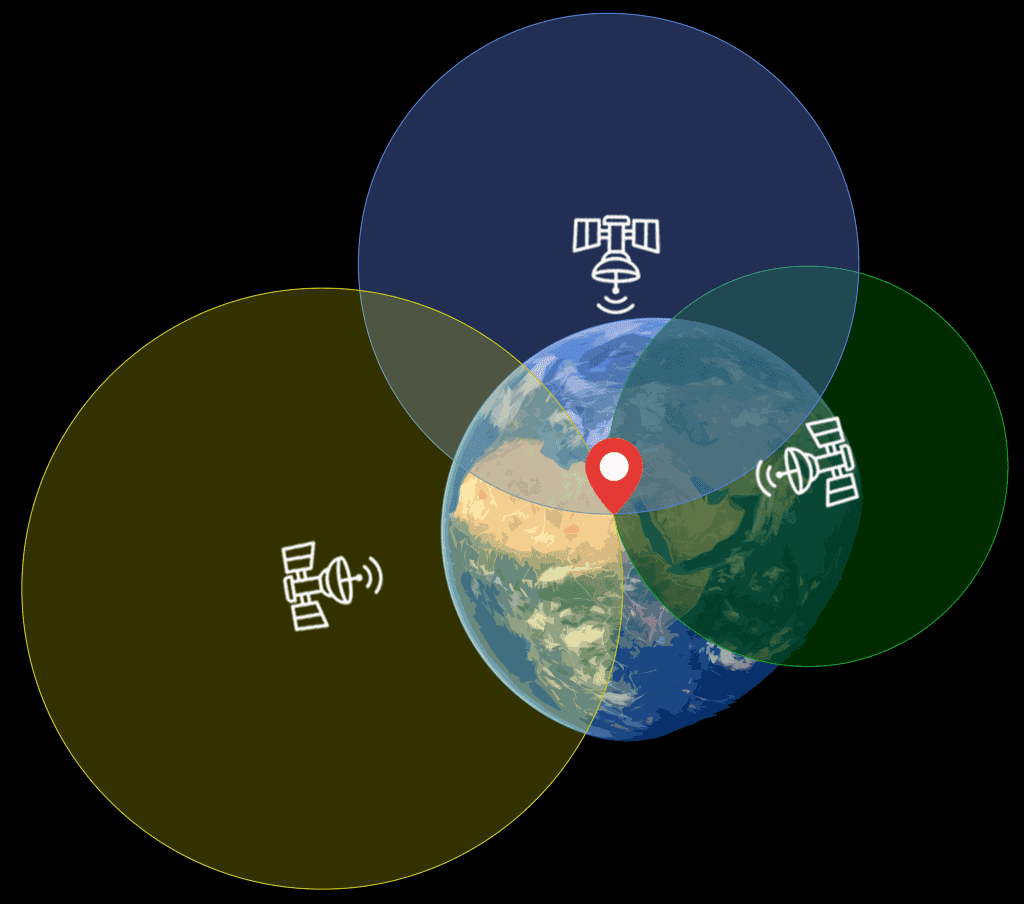
When the GPS sensor is able to find and receive a signal from a satellite, it's chosen a "set up". The GPS sensor needs a set up with at least 3 satellites to get a location reading. Having a fix with more satellites will give you lot a more authentic location.
How to Connect and Program the GPS to Get Raw Data
In order to access the latitude, longitude, and other data from the GPS, we need to take a look at the raw data output by the sensor. In this project we will connect the GPS to the Arduino and output the raw GPS data to the serial monitor.
Hither are the parts you will need:
- Arduino Uno
- Jumper wires
- Adafruit Ultimate GPS Breakout
The GPS uses TTL serial communication to send data to the Arduino, then we can view the sensor readings on the series monitor without any lawmaking. To get the raw GPS readings, connect your GPS to the Arduino like this:
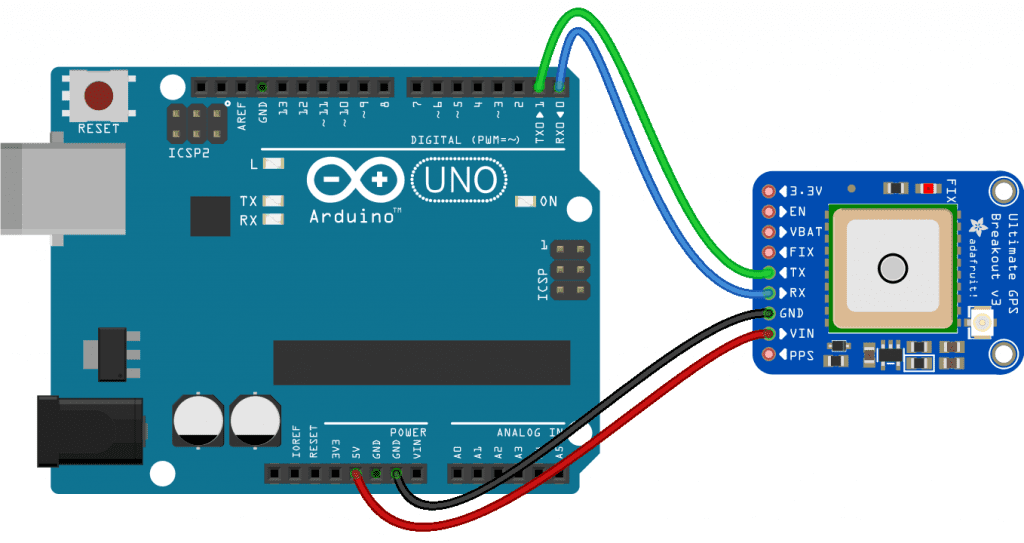
At present open up the series monitor in the Arduino IDE and you should come across the raw GPS readings existence printed out:

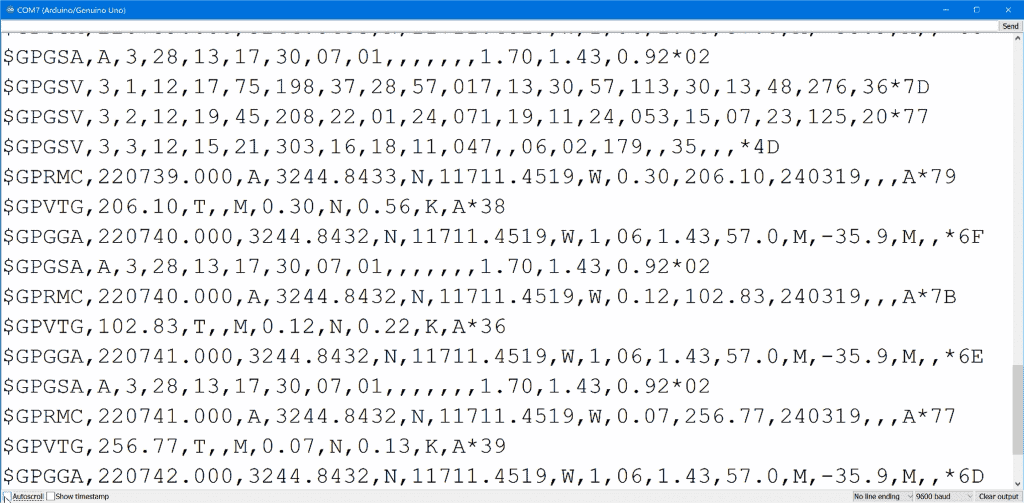
The raw GPS sensor data is provided in NMEA sentences.
What are NMEA Sentences?
There are iv different NMEA sentences in each sensor read – GPRMC, GPVTG, GPGGA, and GPGSA:

The GPRMC Sentence
The GPRMC sentence is the one we will be using the most. GPRMC stands for Global Positioning Recommended Minimum Coordinates. It has almost of the location data we're interested in. Each piece of information is separated past a comma:

Here are the details about each part of the GPRMC sentence:
- Current fourth dimension in Greenwich mean fourth dimension.
- Status code. If the NMEA sentence is valid and the GPS had a satellite fix when it got the data, this will be "A" for active. If it's a "V" the data in the NMEA judgement is void and should not be used.
- Latitude position in the format DDMM.MMMM. The first 2 digits are the degrees, the 2nd 2 digits are the minutes, and the four digits after the decimal are the fractional component of the minutes value.
- Key direction of breadth position. Volition be "N" northward of the equator and "Southward" due south of the equator.
- Longitude position in the format DDDMM.MMMM. The first three digits are the degrees, the second 2 digits are the minutes, and the four digits after the decimal are the partial part of the minutes value.
- Primal management of longitude position. Will exist "Eastward" east of the prime number summit or "W" west of the prime tiptop.
- Ground speed in knots.
- Class made good reading. This is the direction the GPS is travelling, independent of the direction it'southward pointing in degrees from true due north.
- Date of satellite fix. The date of the satellite fix in the format DDMMYY.
- Magnetic variation (AKA magnetic declination) for your current location. It can be used to convert the grade made good value into a heading in degrees. The value is in degrees, along with a value for the cardinal direction.
- Direction of the magnetic variation. Will be either "Due east" for east or "W" for west.
- Checksum. Used to verify that the judgement was transferred to the Arduino without errors.
The GPVTG Judgement
The next sentence is the GPVTG sentence:

The GPVTG judgement contains the track made good and ground speed values.
The GPGGA Sentence
The sentence later on that is the GPGGA sentence:

The GPGGA sentence contains data almost the fix quality and number of satellites with a fix.
The GPGSA Sentence
The last sentence is the GPGSA sentence:

The GPGSA sentence contains more information about the fix quality.
To convert the NMEA sentences into a format we can work with, nosotros need to parse them.
How to Parse the NMEA Sentences
Parsing simply means to read some text and catechumen it into something easier to read. To parse the NMEA sentences, nosotros accept to connect the GPS to the Arduino like this.
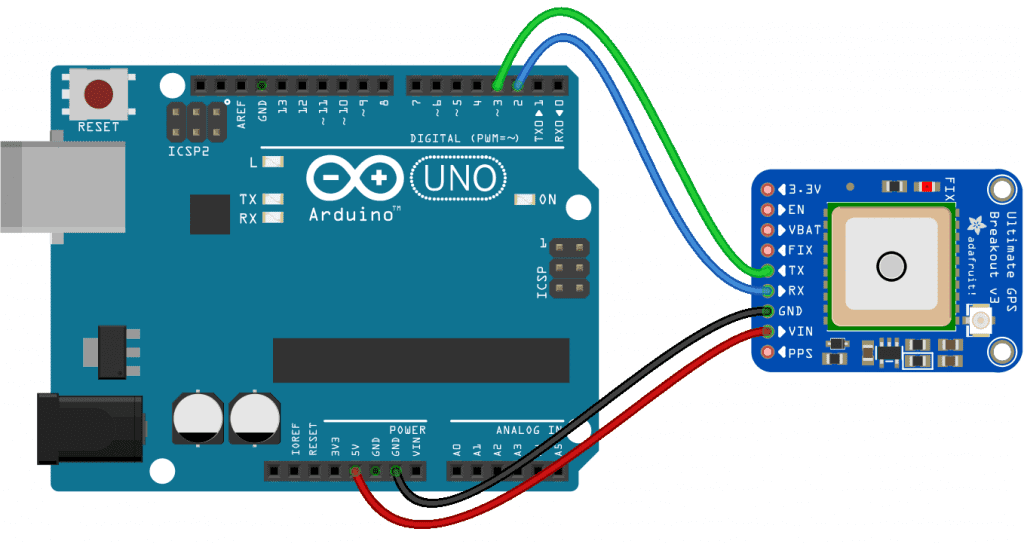
Programming the GPS Sensor for Parsed NMEA Sentences
We will utilise the Adafruit GPS library to program the sensor. You can download it here.
Once the library is installed, upload this sketch the the Arduino:
#include <Adafruit_GPS.h> #include <SoftwareSerial.h> SoftwareSerial mySerial(3, 2); Adafruit_GPS GPS(&mySerial); char c; void setup() { Serial.begin(9600); GPS.brainstorm(9600); GPS.sendCommand(PMTK_SET_NMEA_OUTPUT_RMCGGA); GPS.sendCommand(PMTK_SET_NMEA_UPDATE_1HZ); delay(1000); } void loop() { clearGPS(); while (!GPS.newNMEAreceived()) { c = GPS.read(); } GPS.parse(GPS.lastNMEA()); Serial.print("Fourth dimension: "); Serial.print(GPS.hr, DEC); Serial.impress(':'); Serial.impress(GPS.minute, DEC); Series.impress(':'); Series.impress(GPS.seconds, December); Series.print('.'); Series.println(GPS.milliseconds); Serial.print("Appointment: "); Serial.impress(GPS.solar day, DEC); Serial.print('/'); Series.print(GPS.month, Dec); Serial.print("/xx"); Series.println(GPS.year, December); Series.print("Set: "); Serial.print(GPS.ready); Serial.print(" quality: "); Serial.println(GPS.fixquality); Serial.print("Satellites: "); Serial.println(GPS.satellites); if (GPS.fix) { Serial.impress("Location: "); Serial.print(GPS.latitude, 4); Serial.print(GPS.lat); Serial.impress(", "); Serial.impress(GPS.longitude, 4); Serial.println(GPS.lon); Serial.print("Google Maps location: "); Serial.impress(GPS.latitudeDegrees, 4); Serial.print(", "); Serial.println(GPS.longitudeDegrees, four); Series.print("Speed (knots): "); Series.println(GPS.speed); Serial.print("Heading: "); Serial.println(GPS.bending); Serial.impress("Altitude: "); Series.println(GPS.altitude); } Serial.println("-------------------------------------"); } void clearGPS() { while (!GPS.newNMEAreceived()) { c = GPS.read(); } GPS.parse(GPS.lastNMEA()); while (!GPS.newNMEAreceived()) { c = GPS.read(); } GPS.parse(GPS.lastNMEA()); } Explanation of the Code
First we include the Adafruit GPS and Software Series libraries. The Adafruit GPS library has all of the functions needed to parse the NMEA sentences. The Software Series library creates a new serial port so we can connect the Tx and Rx GPS pins to any Arduino digital pin.

Next we create an object chosen mySerial from the SoftwareSerial class. We pass the object ii parameters. The first parameter is the Arduino pin that is connected to the Rx pin on the GPS. The 2d parameter is the Arduino pin connected to the Tx pin on the GPS.
Then we create another object called GPS to use the functions in the Adafruit GPS library. We need to pass the mySerial object to the GPS object.
Now we declare a variable called c with the char information type. Each NMEA sentence is a string of characters, so the c variable will agree the individual characters in the string while it's being read.
In the setup() section nosotros initialize the series monitor, then initialize the GPS with the begin() part. The brainstorm() function is called through the GPS object. We laissez passer the begin() function the default baud rate of the GPS, which is 9600.
Adjacent nosotros tell the sensor which NMEA sentences we want to receive. The Adafruit GPS library has a function called sendCommand(). If we use PMTK_SET_NMEA_OUTPUT_RMCGGA every bit a parameter, the GPS will merely transport the GPRMC and GPGGA sentences:
GPS.sendCommand(PMTK_SET_NMEA_OUTPUT_RMCGGA);
If you only demand the GPRMC sentence, change the parameter to PMTK_SET_NMEA_OUTPUT_RMCONLY:
GPS.sendCommand(PMTK_SET_NMEA_OUTPUT_RMCONLY);
If y'all want all of the sentences, change the parameter to PMTK_SET_NMEA_OUTPUT_ALLDATA:
GPS.sendCommand(PMTK_SET_NMEA_OUTPUT_ALLDATA);
And then we use the sendCommand() function once again to set up the update rate of the GPS. The update charge per unit specifies how fast the GPS sends location data to the Arduino. Using PMTK_SET_NMEA_UPDATE_1HZ as the parameter sets the update rate to one Hertz:
GPS.sendCommand(PMTK_SET_NMEA_UPDATE_1HZ);
You can modify the update rate to 5 Hertz past using PMTK_SET_NMEA_UPDATE_5HZ:
GPS.sendCommand(PMTK_SET_NMEA_UPDATE_5HZ);
Or you can set it to 10 Hertz past using PMTK_SET_NMEA_UPDATE_10HZ:
GPS.sendCommand(PMTK_SET_NMEA_UPDATE_10HZ);
It takes some time for the sensor to kickoff up and perform these commands, so we have a filibuster of one,000 ms to let the GPS initialize before we offset reading NMEA sentences from information technology.
Before we read a prepare of NMEA sentences, we need to articulate out the series buffer to make certain there isn't any onetime information in information technology. In the loop() section, the clearGPS() office clears out the serial buffer for the next set up of NMEA sentences. The clearGPS() function is defined at the bottom of the sketch. To clear the serial buffer nosotros need accept a reading from the GPS, parse the sentence, and then practise nothing with it. This is done twice, once for each NMEA sentence. In one case that's done, we return to the loop() section.
The NMEA sentences will be output from the GPS at a charge per unit of 1 Hz, or once per second. Therefore we need to tell the Arduino to await until a valid NMEA sentence is ready to be read. We do that with while (!GPS.newNMEAreceived()). This while loop makes the Arduino loop and wait until a NMEA sentence is prepare to be read.
The newNMEAreceived() office returns a truthful value when a new prepare of NMEA sentences have been received, and a false value when no NMEA sentences accept been received. If no NMEA sentence is available to read, the NOT operator makes the condition truthful. Then the program enters the while argument, where the read() function reads the characters coming in through the serial bus. The characters are stored in the c variable. If an NMEA sentence is prepare, the newNMEAreceived() function will return a true value. The NOT operator will make the condition false so the plan skips the while loop and continues on with the rest of the sketch.
Once a valid NMEA sentence has been received from the GPS, we tin can parse it with the parse() function. The lastNMEA() function returns the last NMEA judgement received. So if we apply lastNMEA() as the parameter in the parse() office, the sketch will take the terminal NMEA sentence received and parse information technology.
At present that all of the NMEA sentences take been parsed, we can impress the data to the series monitor. The following variables can be used to print information to the serial monitor or be used every bit inputs into other functions. Note that each variable needs to exist accessed through the GPS object as shown below:
-
GPS.hour– Hour of read (GMT) -
GPS.minute– Minute of read (GMT) -
GPS.seconds– 2nd of read (GMT) -
GPS.milliseconds– Millisecond of read (GMT) -
GPS.day– Mean solar day of read -
GPS.calendar month– Month of read -
GPS.year– Year of read -
GPS.fix– Returns a 1 if the GPS has a satellite gear up and a 0 if it doesn't -
GPS.fixquality– Returns a value indicating how strong the satellite ready is -
GPS.satellites– Returns how many satellites the GPS has a set up on -
GPS.latitude– Returns the numeric raw latitude value formatted the aforementioned manner as the NMEA sentence -
GPS.lat– Returns the fundamental direction of the latitude (North or Southward) -
GPS.longitude– Returns the numeric raw longitude value formatted the aforementioned way as the NMEA judgement -
GPS.lon– Returns the primal direction of the longitude (E or W) -
GPS.latitudeDegrees– Returns the latitude in degrees -
GPS.longitudeDegrees– Returns the longitude in degrees -
GPS.speed– Returns the speed in knots -
GPS.angle– Returns the heading in degrees -
GPS.distance– Returns the altitude in meters
How to Use the GPS on the Arduino
In one case you lot've connected the GPS sensor to your Arduino and uploaded the sketch, wait until the Prepare LED starts blinking to indicate satellite fixes. Information technology will blink once per second when in that location's no satellite fix , and once every 15 seconds when in that location is a set.
For best results, accept the GPS outside where in that location is a articulate view of the sky. Depending on where y'all are, it tin take about a infinitesimal or longer to get a fix. Once the GPS gets a fix on a few satellites, you'll meet data like this being printed out on the series monitor:
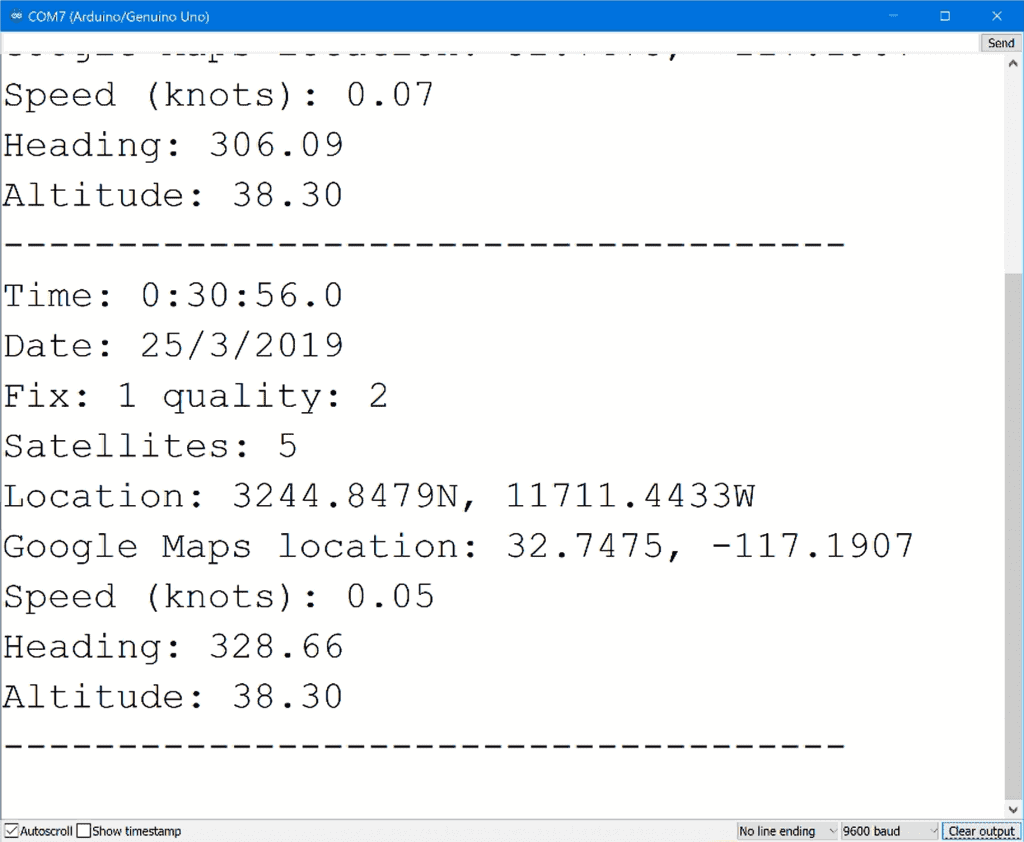
Exist certain to get out a annotate below if you have any questions or have trouble setting this up!

Source: https://www.circuitbasics.com/how-to-setup-a-gps-sensor-on-the-arduino/
Post a Comment for "arduino upload program particle sensor serial monitor doesnt work"